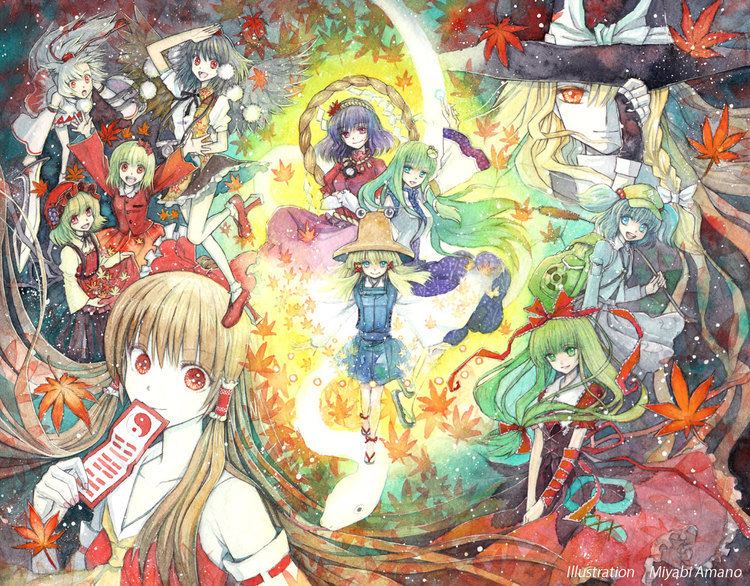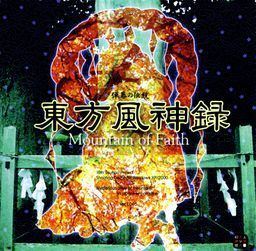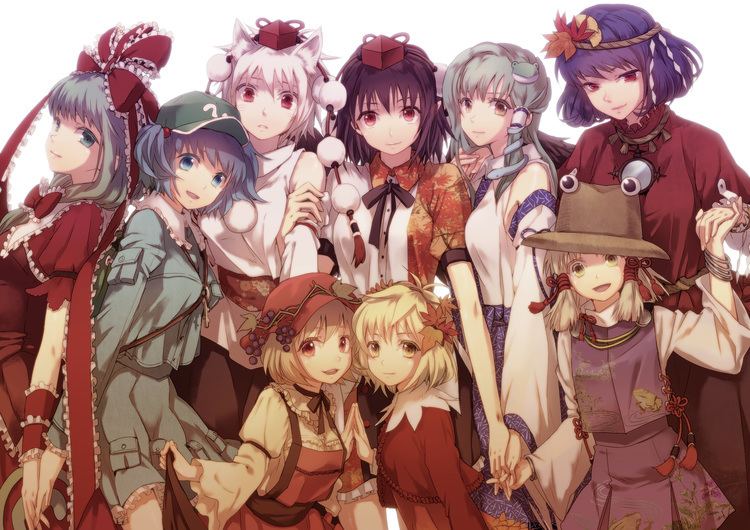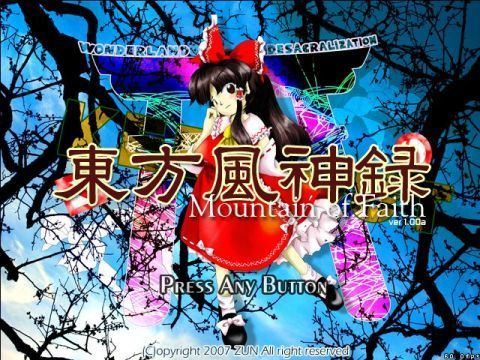9 /10 1 Votes9
Genre(s) Scrolling shooter | 4.5/5 Amazon Initial release date 17 August 2007 Developer Team Shanghai Alice Mode Single-player video game | |||||||||||||||||||||||||||||||||
 | ||||||||||||||||||||||||||||||||||
Similar Subterranean Animism, Perfect Cherry Blossom, Phantasmagoria of Flower View, Imperishable Night, Undefined Fantastic Object | ||||||||||||||||||||||||||||||||||
Mountain of faith attack comparison
Touhou Fūjinroku ~ Mountain of Faith (東方風神録 ~ Mountain of Faith., lit. Eastern Wind God Chronicles) is the tenth game of the Touhou Project, according to the official numbering by its creator ZUN of Team Shanghai Alice. Like the majority of the Touhou Project games, Mountain of Faith is a doujin scrolling shooter, albeit with a major revamp from its predecessors. The game was released in the Comiket 72 in August 2007.
Contents
- Mountain of faith attack comparison
- Touhou piano mountain of faith medley 1st movement
- Gameplay
- Plot
- Characters
- Development
- Reception
- References

Touhou piano mountain of faith medley 1st movement
Gameplay

Mountain of Faith plays like a fairly typical vertically scrolling shooter, in which the player's character is always facing towards the top of the screen, shooting at anything that moves, avoiding and weaving between enemy bullets, and confronting a difficult boss at the end of each stage.

Unlike previous Touhou games, there is no separate bomb counter. Instead, there's a relationship between the power gauge, bombs, and options. Options are the small "satellites" that stick around the player's character and shoot shots. The more power items collected, the higher the power gauge rises. The power gauge takes on values from 0 to 5, and decimal numbers in between. The number of options the player has corresponds to the integer part of the power gauge – e.g., if the player has a power level of 2.75, he would have two options. When a bomb is used, an option is discarded. Hence using bombs would lower the power levels, though that can be replenished with items.
The defining feature of Mountain of Faith's scoring mechanics is the Faith Point system. A "faith counter" at the lower-left corner of the screen determines how many points items and spell card bonuses are worth. The counter will decrease as time progresses, though the decrease can be halted temporarily by defeating enemies and collecting items. The counter can be replenished by collecting green stars and orbs, known as Faith Point items.
Mountain of Faith comes with a unique feature that allows players to show customized text overlaid on the playing area. The feature can be set to auto, where the game automatically alerts places where the player had died before with a "Caution!" note. The player can also edit the hint file to show personalized notes at certain places and times, making it possible for simple play-along strategy guides to be made and distributed with "Nico Nico Douga-like interactivity". There are two playable characters, each with three weapon types, but no personalized Spell Card bombs like previous games.
Plot
Autumn has come to the secluded land of Gensokyo, and to its only shrine, the Hakurei Shrine, a common meeting place for its youkai that was seldom visited by its humans. As a result, faith in the Hakurei Shrine's deity began to fall like the leaves from the trees. It's in such a season that Reimu Hakurei, the shrine maiden of the Hakurei shrine, is visited by a mysterious stranger who claims to represent a god of mountains and orders her to shut the shrine's doors for good. Reimu is deeply troubled by this state of affairs, as she knows the shrine can't be allowed to close down due to the role it plays in watching over the Great Hakurei Border that separates Gensokyo from the outside world. Marisa Kirisame, her magician friend, is suspicious and also suitably bored. The girls decide to ascend the Youkai Mountain to confront the mysterious deity behind the threats.
Ignoring the lesser gods and the kappa's advices to turn back, Reimu and Marisa climb the Youkai Mountain to find that the tengu society fretting over the presence of a new shrine on the mountain. Turning their attention to the new shrine, the Moriya Shrine on the mountain, the girls find Sanae Kotiya, the messenger who ordered them to shut down the Hakurei Shrine. Sanae is the priestess serving the god Kanako Yasaka, who plots to gather the faith of all of Gensokyo's denizens in order to prevent the declining level of faith in Gensokyo to reach the point where its gods lose their power. Reimu, objecting the plan on the basis that it will render her shrine obsolete, battle the occupants of the new shrine. After a protracted battle, Kanako is convinced to make peace with the tengu and kappa, who are also convinced to accept her as the goddess of the Youkai Mountain.
In the Extra Mode, Reimu and Marisa hear of a rumor that another god lives in the Moriya Shrine, and so set out for the mountain again. There they meet the true god of the Moriya Shrine, Suwako Moriya, who demands the girls to play with her.
ZUN stated in an interview that the plot of Mountain of Faith was never resolved in itself. This was so that future instalments, like Subterranean Animism, can base their stories on the loose ends of Mountain of Faith.
Characters
Playable characters:
Boss characters:
Development
With the end of Imperishable Night, ZUN, the sole creator of the Touhou Project, achieved his original goal of making three Touhou games for Windows. Although he had thoughts to make the next game return to the simplicity of The Embodiment of Scarlet Devil, he shelved the idea to work on excursions from the main series. After making Phantasmagoria of Flower View, ZUN decided to wait one year before making another game to see if the Touhou fandom would die down. Conversely, the Touhou fandom continued to grow, and ZUN decided to make the next game.
ZUN had wanted to make the tenth game of the Touhou Project to be nostalgic to him, so he based Mountain of Faith on the Suwa myths he heard in his youth. Since Suwa mythology had largely faded from public consciousness, ZUN thought it would be interesting to provide his own spin on Suwa mythology; to do this, he went on a trip to research the gods of the Suwa region.
One of the main point for Mountain of Faith, in ZUN's mind, is to go back to the basics. For this reason, Mountain of Faith did not inherit the Spell Practice mode from Imperishable Night nor the unique character bombs from previous games. Using Shoot the Bullet as prototype, ZUN extended the spinoff game into Mountain of Faith, thus starting off from scratch instead of using the models of his well-established games. ZUN has stated that being able to revamp the game system and remove existing features freely is one of the advantages of doujin production.
Reception
The game has been lauded for its difficulty, as with other Touhou games. However, Yukikuni Sasayami of 4Gamer.net noted that although the bullet patterns have become more difficult than past Touhou games, the durations of the patterns have become shorter, making it easier for players to outlast the patterns. The game has also been described by Sasayama as "spellcard-centric", where the game encourages bombing until the specialized bullet patterns known as "spell cards". Hence Mountain of Faith lets the players experience the rhythmic onslaught of spell cards, which may be the reason why Mountain of Faith did not inherit the Spell Practice mode from Imperishable Night, since it fragments the spell cards.
The popularity of Touhou Project brought many fans outside the Nagano Prefecture to the shrines of Suwa, from where Mountain of Faith draws its inspiration. Prayer plaques with manga drawings starting to appear in the Suwa Taisha since July 2008 as a result of these "holy sites pilgrimages". The Moriya Priests Museum of Documents (神長官守矢史料館) in Chino, Nagano reports that the number of visitors in 2008 rivals that of 2007, when tourists were likewise drawn to Suwa because of the Taiga drama Fūrin Kazan. Some locals hoped that recent developments would lead to new ways to attract tourists, as was the case of Washimiya, Saitama.
